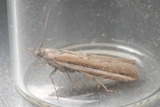Pima boisduvaliella (Guenée, 1845) Species
Last modified: Nov. 1, 2023, 4:45 p.m.
A very rare and local species in Belgium, mainly known from very old records from WV.
Recently (2021) observed again in the extreme west of WV.
Details
- Classification
- Family: Pyralidae > Subfamily: Phycitinae > Tribus: Phycitini > Genus: Pima > Species: Pima boisduvaliella
- Vernacular names
- Kraslijnmot (NL), Silver-edged Knot-horn (EN), La Phycide de Boisduval (FR)
- Synonyms
- Pima farrella (Curtis, 1850)
- First mention in Belgium
- Fologne E. 1864. Lépidoptères nouveaux pour la faune belge observés par E. Fologne. — Annales de la Société Entomologique de Belgique 8: 273–276. On page 273.
- Status
-
Native
Distribution
Genitalia
Male: an elongate valva with a well-developed costa that produced and weakly notched apically, the broad semicircular juxta with a pair of short, finger-like lateral lobes, the V-shaped vinculum ca 1.5 x length of its greatest width and the aedeagus with two thorns that are slightly less than half the length of the aedeagus.
Female: antrum rounded, a heart-shaped corpus bursae with dense microtrichia in anterior 1 / 3, with a small oval sclerotized plate and a couple of tortuous, sclerotized plates.
Bionomics
The larva feeds internally in the pods on the food plant and pupates in a sand-covered cocoon in the soil. The adults fly during warm evenings and later come to light.
Flight periods
The adults are on the wing from June towards late August.
Observed on
- Host plant (species):
- Lotus corniculatus, Ononis spinosa and Lathyrus japonicus
- Host plant (genera):
- Anthyllis
The larvae feed on Lathyrus japonicus, Lotus corniculatus and Ononis spinosa. feeding internally in the pods.
Habitat
It inhabits sand-dunes and shingle beaches.

